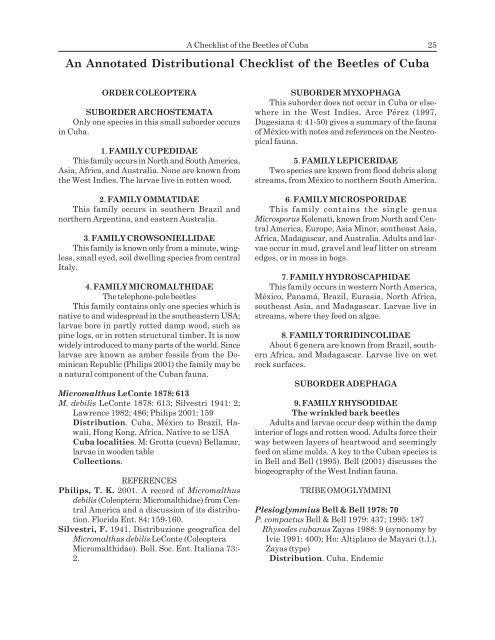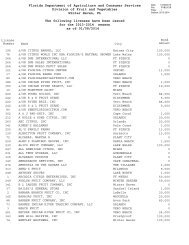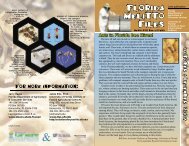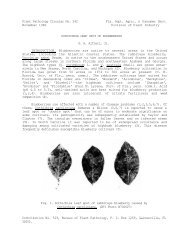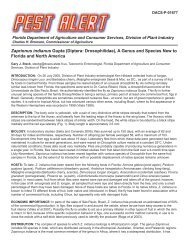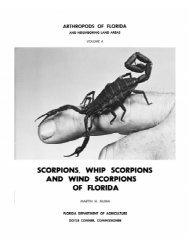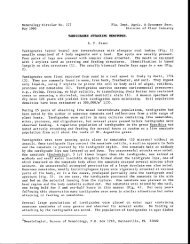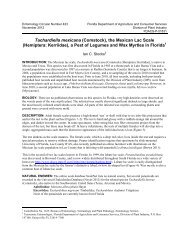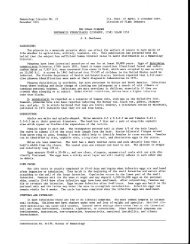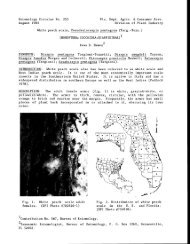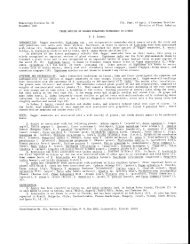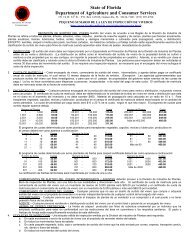A Checklist of the Beetles of Cuba with Data on Distributions and ...
A Checklist of the Beetles of Cuba with Data on Distributions and ...
A Checklist of the Beetles of Cuba with Data on Distributions and ...
You also want an ePaper? Increase the reach of your titles
YUMPU automatically turns print PDFs into web optimized ePapers that Google loves.
A <str<strong>on</strong>g>Checklist</str<strong>on</strong>g> <str<strong>on</strong>g>of</str<strong>on</strong>g> <str<strong>on</strong>g>the</str<strong>on</strong>g> <str<strong>on</strong>g>Beetles</str<strong>on</strong>g> <str<strong>on</strong>g>of</str<strong>on</strong>g> <str<strong>on</strong>g>Cuba</str<strong>on</strong>g> 25<br />
An Annotated Distributi<strong>on</strong>al <str<strong>on</strong>g>Checklist</str<strong>on</strong>g> <str<strong>on</strong>g>of</str<strong>on</strong>g> <str<strong>on</strong>g>the</str<strong>on</strong>g> <str<strong>on</strong>g>Beetles</str<strong>on</strong>g> <str<strong>on</strong>g>of</str<strong>on</strong>g> <str<strong>on</strong>g>Cuba</str<strong>on</strong>g><br />
ORDER COLEOPTERA<br />
SUBORDER ARCHOSTEMATA<br />
Only <strong>on</strong>e species in this small suborder occurs<br />
in <str<strong>on</strong>g>Cuba</str<strong>on</strong>g>.<br />
1. FAMILY CUPEDIDAE<br />
This family occurs in North <strong>and</strong> South America,<br />
Asia, Africa, <strong>and</strong> Australia. N<strong>on</strong>e are known from<br />
<str<strong>on</strong>g>the</str<strong>on</strong>g> West Indies. The larvae live in rotten wood.<br />
2. FAMILY OMMATIDAE<br />
This family occurs in sou<str<strong>on</strong>g>the</str<strong>on</strong>g>rn Brazil <strong>and</strong><br />
nor<str<strong>on</strong>g>the</str<strong>on</strong>g>rn Argentina, <strong>and</strong> eastern Australia.<br />
3. FAMILY CROWSONIELLIDAE<br />
This family is known <strong>on</strong>ly from a minute, wingless,<br />
small eyed, soil dwelling species from central<br />
Italy.<br />
4. FAMILY MICROMALTHIDAE<br />
The teleph<strong>on</strong>e-pole beetles<br />
This family c<strong>on</strong>tains <strong>on</strong>ly <strong>on</strong>e species which is<br />
native to <strong>and</strong> widespread in <str<strong>on</strong>g>the</str<strong>on</strong>g> sou<str<strong>on</strong>g>the</str<strong>on</strong>g>astern USA;<br />
larvae bore in partly rotted damp wood, such as<br />
pine logs, or in rotten structural timber. It is now<br />
widely introduced to many parts <str<strong>on</strong>g>of</str<strong>on</strong>g> <str<strong>on</strong>g>the</str<strong>on</strong>g> world. Since<br />
larvae are known as amber fossils from <str<strong>on</strong>g>the</str<strong>on</strong>g> Dominican<br />
Republic (Philips 2001) <str<strong>on</strong>g>the</str<strong>on</strong>g> family may be<br />
a natural comp<strong>on</strong>ent <str<strong>on</strong>g>of</str<strong>on</strong>g> <str<strong>on</strong>g>the</str<strong>on</strong>g> <str<strong>on</strong>g>Cuba</str<strong>on</strong>g>n fauna.<br />
Micromalthus LeC<strong>on</strong>te 1878: 613<br />
M. debilis LeC<strong>on</strong>te 1878: 613; Silvestri 1941: 2;<br />
Lawrence 1982; 486; Philips 2001: 159<br />
Distributi<strong>on</strong>. <str<strong>on</strong>g>Cuba</str<strong>on</strong>g>, México to Brazil, Hawaii,<br />
H<strong>on</strong>g K<strong>on</strong>g, Africa. Native to se USA<br />
<str<strong>on</strong>g>Cuba</str<strong>on</strong>g> localities. M: Grotta (cueva) Bellamar,<br />
larvae in wooden table<br />
Collecti<strong>on</strong>s.<br />
REFERENCES<br />
Philips, T. K. 2001. A record <str<strong>on</strong>g>of</str<strong>on</strong>g> Micromalthus<br />
debilis (Coleoptera: Micromalthidae) from Central<br />
America <strong>and</strong> a discussi<strong>on</strong> <str<strong>on</strong>g>of</str<strong>on</strong>g> its distributi<strong>on</strong>.<br />
Florida Ent. 84: 159-160.<br />
Silvestri, F. 1941. Distribuzi<strong>on</strong>e geografica del<br />
Micromalthus debilis LeC<strong>on</strong>te (Coleoptera<br />
Micromalthidae). Boll. Soc. Ent. Italiana 73:-<br />
2.<br />
SUBORDER MYXOPHAGA<br />
This suborder does not occur in <str<strong>on</strong>g>Cuba</str<strong>on</strong>g> or elsewhere<br />
in <str<strong>on</strong>g>the</str<strong>on</strong>g> West Indies. Arce Pérez (1997,<br />
Dugesiana 4: 41-50) gives a summary <str<strong>on</strong>g>of</str<strong>on</strong>g> <str<strong>on</strong>g>the</str<strong>on</strong>g> fauna<br />
<str<strong>on</strong>g>of</str<strong>on</strong>g> México <str<strong>on</strong>g>with</str<strong>on</strong>g> notes <strong>and</strong> references <strong>on</strong> <str<strong>on</strong>g>the</str<strong>on</strong>g> Neotropical<br />
fauna.<br />
5. FAMILY LEPICERIDAE<br />
Two species are known from flood debris al<strong>on</strong>g<br />
streams, from México to nor<str<strong>on</strong>g>the</str<strong>on</strong>g>rn South America.<br />
6. FAMILY MICROSPORIDAE<br />
This family c<strong>on</strong>tains <str<strong>on</strong>g>the</str<strong>on</strong>g> single genus<br />
Microsporus Kolenati, known from North <strong>and</strong> Central<br />
America, Europe, Asia Minor, sou<str<strong>on</strong>g>the</str<strong>on</strong>g>ast Asia,<br />
Africa, Madagascar, <strong>and</strong> Australia. Adults <strong>and</strong> larvae<br />
occur in mud, gravel <strong>and</strong> leaf litter <strong>on</strong> stream<br />
edges, or in moss in bogs.<br />
7. FAMILY HYDROSCAPHIDAE<br />
This family occurs in western North America,<br />
México, Panamá, Brazil, Eurasia, North Africa,<br />
sou<str<strong>on</strong>g>the</str<strong>on</strong>g>ast Asia, <strong>and</strong> Madagascar. Larvae live in<br />
streams, where <str<strong>on</strong>g>the</str<strong>on</strong>g>y feed <strong>on</strong> algae.<br />
8. FAMILY TORRIDINCOLIDAE<br />
About 6 genera are known from Brazil, sou<str<strong>on</strong>g>the</str<strong>on</strong>g>rn<br />
Africa, <strong>and</strong> Madagascar. Larvae live <strong>on</strong> wet<br />
rock surfaces.<br />
SUBORDER ADEPHAGA<br />
9. FAMILY RHYSODIDAE<br />
The wrinkled bark beetles<br />
Adults <strong>and</strong> larvae occur deep <str<strong>on</strong>g>with</str<strong>on</strong>g>in <str<strong>on</strong>g>the</str<strong>on</strong>g> damp<br />
interior <str<strong>on</strong>g>of</str<strong>on</strong>g> logs <strong>and</strong> rotten wood. Adults force <str<strong>on</strong>g>the</str<strong>on</strong>g>ir<br />
way between layers <str<strong>on</strong>g>of</str<strong>on</strong>g> heartwood <strong>and</strong> seemingly<br />
feed <strong>on</strong> slime molds. A key to <str<strong>on</strong>g>the</str<strong>on</strong>g> <str<strong>on</strong>g>Cuba</str<strong>on</strong>g>n species is<br />
in Bell <strong>and</strong> Bell (1995). Bell (2001) discusses <str<strong>on</strong>g>the</str<strong>on</strong>g><br />
biogeography <str<strong>on</strong>g>of</str<strong>on</strong>g> <str<strong>on</strong>g>the</str<strong>on</strong>g> West Indian fauna.<br />
TRIBE OMOGLYMMINI<br />
Plesioglymmius Bell & Bell 1978: 70<br />
P. compactus Bell & Bell 1979: 437; 1995: 187<br />
Rhysodes cubanus Zayas 1988: 9 (syn<strong>on</strong>omy by<br />
Ivie 1991: 400); Ho: Altiplano de Mayari (t.l.),<br />
Zayas (type)<br />
Distributi<strong>on</strong>. <str<strong>on</strong>g>Cuba</str<strong>on</strong>g>. Endemic


